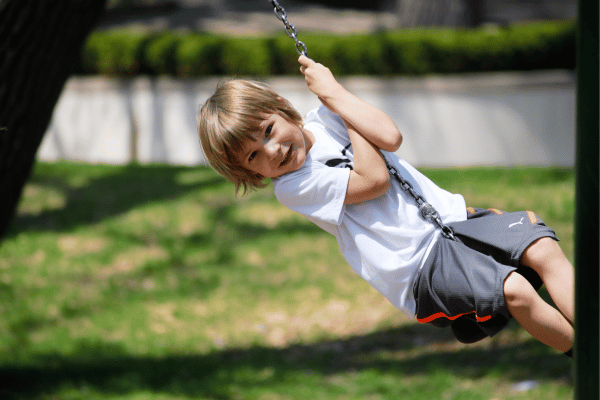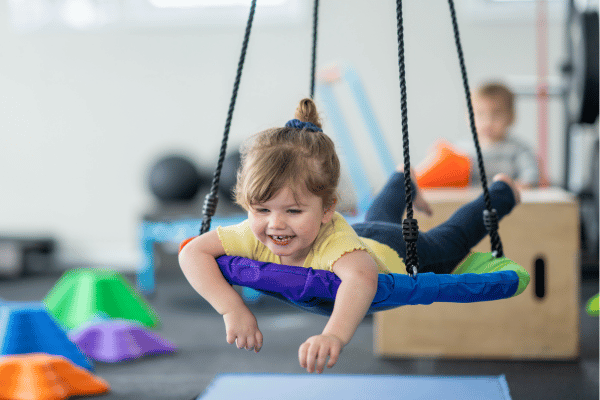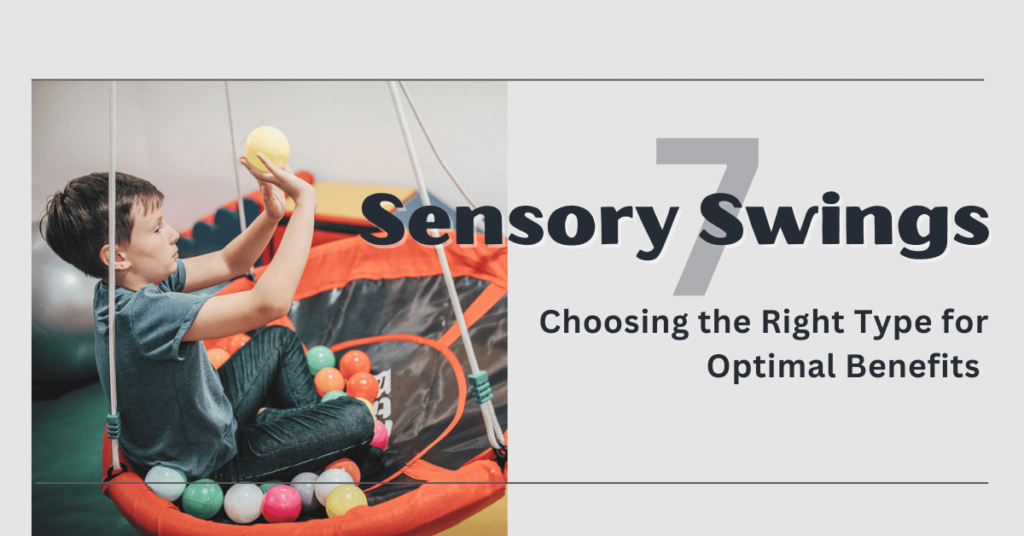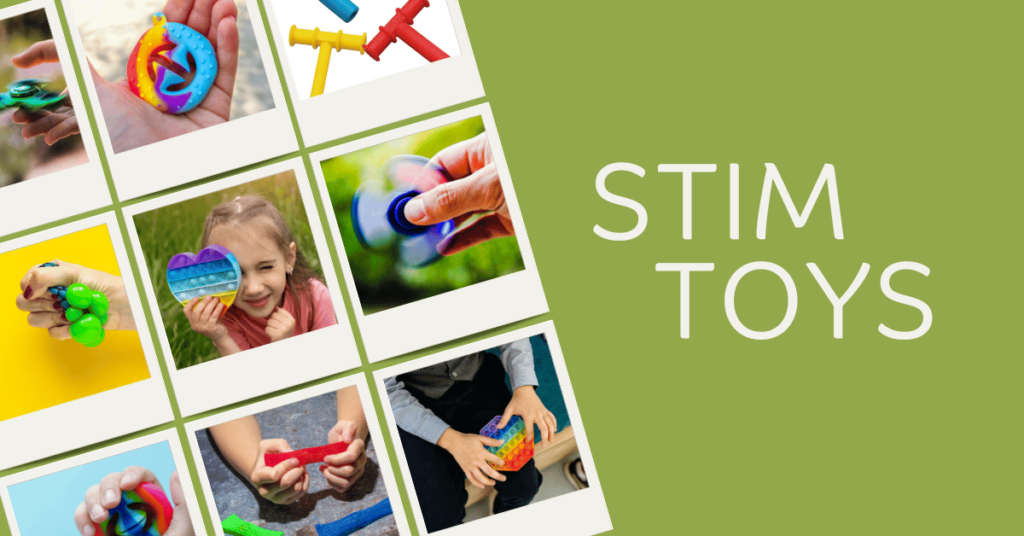Disclosure: This post may contain affiliate links. This means that if you click on a link and make a purchase, we may earn a commission at no additional cost. We only promote products we believe in, and your support helps us continue providing valuable content to our readers.
- I. Introduction
- II. What is a Sensory Swing?
- III. Benefits of Using Sensory Swings
- IV. Top 7 Sensory Swing Types
- V. How to Choose the Right Sensory Swing
- VI. Tips for Using Sensory Swings Effectively
- VII. Activities and Exercises with Sensory Swings
- VIII. Safety Considerations
- IX. Conclusion: Embracing Peace and Well-being
- X. Frequently Asked Questions (FAQs)
I. Introduction
Taking care of individuals with autism and ADHD comes with unique challenges. As caregivers, it’s essential to explore tools and strategies that can provide comfort and support to our loved ones. A tool that is becoming more and more popular is the sensory swing.
Due to its therapeutic advantages and adaptability in helping people with sensory processing disorders, autism spectrum disorder, ADHD, and other developmental difficulties, sensory swings have become more and more well-known in recent years. We’ll dive into the realm of sensory swings in this in-depth guide, covering their types and advantages, activities, and much more.
II. What is a Sensory Swing?
A sensory swing, also known as a therapy swing or therapeutic swing, is a specialized type of swing intended to provide sensory input and promote sensory integration. It is designed to provide the user with proprioceptive and vestibular input. Unlike regular swings, sensory swings are usually constructed from soft, stretchy fabric or other sensory-friendly materials. They are available in various shapes and sizes, catering to different sensory needs and preferences.
The swinging motion stimulates the vestibular system, contributing to balance, spatial orientation, and movement regulation. Additionally, the pressure and movement of the swing provide proprioceptive input, improving body awareness and soothing the nervous system.
III. Benefits of Using Sensory Swings
Physical Well-being
- Improved balance and coordination. Individuals develop better proprioception and spatial awareness by engaging in swinging movements, leading to improved balance and coordination skills. It is highly beneficial for children with developmental delays or motor skill difficulties.
- Strengthening of core muscles. Swinging helps people maintain balance and stability, strengthening their back, pelvic, and abdominal muscles. It can contribute to improved posture and overall physical strength.
- Enhances proprioception and body awareness. The swing’s rhythmic motion provides sensory input that enhances proprioceptive feedback, helping individuals understand and control their body movements in space. This increased body awareness can improve motor planning and coordination. You can check out other tools and toys that provide proprioceptive input in other articles.
- Encourages relaxation and lessens muscle tension. The gentle, repetitive motion of swinging has a calming effect on the neurological system, promoting relaxation and reducing muscle tension. It can be beneficial for individuals who suffer from muscle stiffness or tension due to stress or sensory overload.
Emotional Comfort
- Calming effect, lowering tension and anxiety. The soothing motion of swinging stimulates the release of endorphins. These neurotransmitters promote feelings of calmness and relaxation and encourage sensations of relaxation and peace.
- Increases feelings of security and comfort. The enveloping sensation of being in a sensory swing creates a cocoon-like environment that fosters feelings of safety and security, offering a soothing sensory experience for individuals who might be feeling stressed or overwhelmed.
- Encourages self-regulation and emotional expression. Swinging provides a regulated sensory experience that can help individuals learn to self-regulate their emotions and behaviors, which in turn promotes emotional regulation and self-control. Additionally, the freedom of movement in the swing can encourage emotional expression and communication.
- Enhances mood and overall well-being. The combination of sensory input, relaxation, and emotional regulation provided by swinging can have a positive impact on mood and overall well-being. It promotes feelings of happiness, contentment, and relaxation.
Cognitive Enhancement
- Stimulates sensory processing and integration. The sensory input provided by swinging stimulates various sensory systems. It includes proprioception, vestibular, and tactile senses, promoting sensory processing and integration. It helps individuals better understand and interpret sensory information from their environment.
- Enhances focus and attention. The rhythmic motion of swinging can help individuals achieve a state of focused attention. It also improves concentration and cognitive focus. It can be very beneficial for individuals with attention deficit hyperactivity disorder (ADHD) or sensory processing difficulties.
- Improves sensory discrimination skills. Swinging exercises force people to distinguish between various sensory cues, such as variations in movement speed or direction. Enhancing sensory discriminating abilities can result in enhanced sensory processing and awareness.
- Facilitates learning and academic performance. Swinging can help to establish the ideal conditions for learning and academic achievement by encouraging relaxation, lowering stress levels, and enhancing focus and attention. Incorporating swinging activities into educational settings can enhance engagement, participation, and learning outcomes.
IV. Top 7 Sensory Swing Types
1. Stretchy/Yoga Swing
Stretchy or yoga swings are made of elastic fabric that stretches to fit the contours of the user’s body, resembling a hammock-like structure.

Primary Purpose: The moderate compression and support these swings offer encourage proprioceptive input and relaxation. The elastic fabric allows for a snug fit, enveloping the individual in a cocoon-like embrace, which can induce a sense of security and comfort.
This swing type is particularly beneficial for individuals seeking deep pressure input, as the elastic material gently compresses against the body, providing a soothing sensation. They are often used for swinging, stretching, and inverted poses in therapeutic settings. They are suitable for both sensory and therapeutic purposes.
2. Pod Swing
Pod swings, or cocoon or sensory pod swings, feature a pod-shaped seat suspended from a single attachment point. It resembles a cozy nest or cocoon.
Primary Purpose: These swings are designed to offer a cozy and enclosed space for relaxation and sensory exploration. The pod-shaped seat provides a sense of containment and security. It allows individuals to retreat into their private sanctuary.
Pod swings are famous for sensory integration activities, as they create a calming sensory environment that promotes relaxation and emotional regulation. They provide a safe and comfortable space for individuals to wrap themselves. They offer a therapeutic outlet for self-soothing and sensory modulation. You can use them indoors or outdoors to create a calming sensory retreat. In this place, individuals can escape from the outside world’s demands.
3. Hammock Swing
Hammock swings consist of a fabric hammock suspended from multiple attachment points. It resembles a traditional hammock but is designed for swinging.

Primary Purpose: These swings provide a supportive and ergonomic design for deep pressure and tactile stimulation. The fabric hammock offers a comfortable and enveloping seat, allowing individuals to recline or sit while experiencing gentle swinging motion.
Hammock swings are ideal for individuals who seek deep pressure input and enjoy being cradled. They promote relaxation and sensory exploration, making them suitable for therapeutic activities and leisurely swinging.
4. Platform Swing
Platform swings feature a flat, rectangular surface suspended from multiple attachment points. It provides ample space for individuals to sit, lie, or stand while swinging.
Primary Purpose: These swings offer versatility and stability for active play and social interaction. The spacious platform allows for various seating positions and movement options. It can accommodate individuals of different ages and abilities.
Platform swings promote gross motor skills development, balance, and coordination. They are suitable for sensory integration activities and group play. They encourage cooperative play and teamwork, fostering social skills and communication among participants.
5. Disc Swing
Disc swings feature a flat, disc-shaped seat suspended from ropes or chains. It resembles a traditional playground swing with a broader, more stable platform.

Primary Purpose: These swings offer a stable platform for balance, coordination, and vestibular stimulation. The disc-shaped seat provides ample space for individuals to sit or lie down comfortably while swinging.
Disc swings promote gross motor skills development and vestibular integration. They are a popular choice for sensory integration activities and outdoor play. They suit individuals of all ages and abilities, offering a safe and enjoyable swinging experience.
6. Bolster Swing
Bolster swings consist of a cylindrical or bolster-shaped cushion suspended from a single attachment point. It provides a supportive surface for reclining or sitting.
Primary Purpose: These swings offer gentle rocking or swaying motion for a relaxed sensory experience. The bolster-shaped cushion provides a comfortable and supportive seating area. It allows individuals to recline or sit while experiencing a soothing swinging motion.
Bolster swings promote relaxation and sensory modulation. They are ideal for calming sensory activities and therapeutic exercises. They encourage deep breathing and relaxation techniques, fostering emotional regulation and well-being. Bolster swings can be used indoors or outdoors. You can use them to create a calming sensory retreat where individuals can unwind and respite from daily life’s demands.
7. Saucer Swing
Saucer swings, or UFO or flying saucer swings, are large, round swings with a fabric seat suspended from sturdy ropes or chains.

Primary Purpose: These swings provide a spacious, supportive seat for gentle rocking and vestibular stimulation. The saucer-shaped seat offers a comfortable and secure seating area. It allows individuals to recline or sit while experiencing a soothing swinging motion.
Saucer swings promote relaxation and sensory integration, making them ideal for calming sensory activities and outdoor play. They can accommodate multiple users. You can use them to encourage social interaction, fostering cooperative play and communication skills.
V. How to Choose the Right Sensory Swing
When selecting a sensory swing, it’s essential to consider various factors to ensure it meets the individual’s needs and safety requirements.
Weight capacity and size. It’s essential to ensure that the sensory swing can securely support the weight of the intended user. To avoid mishaps or damage to the swing, find out how much weight the device can support and compare it to the user’s weight. Consider the swing’s dimensions, ensuring adequate room for comfortable positioning and movement.
Installation options and space availability. Consider the location of the sensory swing installation and the availability of appropriate mounting options. While outside swings require a robust tree branch or swing set, inside swings must be attached to a door frame or ceiling beam. Ensure adequate room is at the selected location so the swing can move freely without being obstructed.
Sensory preferences and needs. It’s important to consider the person’s needs and preferences before purchasing a sensory swing. While some people may benefit from more intensive vestibular stimulation, others may prefer mild, rhythmic motions. Understanding these preferences can help select a swing with the most beneficial sensory experience.
Durability and materials. Look for a sensory swing constructed from high-quality, durable materials that can endure regular use and provide long-lasting support. Check the construction of the swing, including the stitching, seams, and attachment points, to ensure it can withstand the weight and movement without tearing or breaking. For outdoor swings, consider additional elements like UV protection to avoid fading and degradation from sun exposure.
Choose a sensory swing made from durable, sensory-friendly materials that provide comfort without irritating. Look for swings constructed from soft, breathable fabrics or other sensory-friendly materials that are gentle on the skin and provide a pleasant tactile experience.
Adjustability and customization options. Look for sensory swings that offer adjustability and customization options to accommodate the user’s specific needs and preferences. Features such as adjustable straps, harnesses, and seating positions allow personalized comfort and support. Additionally, some swings may offer accessories or can come with attachments, such as sensory toys or bolster cushions, to enhance the sensory experience and meet individual requirements.
Safety Features. Look for swings with safety straps or harnesses to secure the user and prevent falls. These features are particularly crucial for people struggling with balance or requiring additional support. Prioritizing safety alongside sensory needs ensures a secure and enjoyable experience for the user.
Extra Features. Some swings include additional features like adjustable heights, padded seats, or removable covers for easy cleaning. Consider this in light of the person’s preferences and sensory requirements. These features can enhance the sensory experience, promote comfort, and offer convenience for caregivers or therapists.
VI. Tips for Using Sensory Swings Effectively
To maximize the benefits of a sensory swing, consider the following tips:
Consistent Routine. Incorporating swing time into an individual’s daily routine can provide a sense of predictability and structure, which is particularly beneficial for those with autism and ADHD. Establishing a regular schedule for swing sessions helps the individual anticipate and prepare for the sensory experience, promoting a sense of security and comfort. Consistency is essential to optimizing the benefits of sensory swinging, whether it’s incorporated into a daily sensory break, a sensory diet, or a set time before or after meals.
Gradual Introductions. For individuals who are new to swinging or who might be sensitive to sensory input, it’s essential to start with short sessions. You can then gradually increase the duration as they become more comfortable. To help the person get used to the feeling, start slowly and gently and then progressively increase the speed and intensity over time. By gradually introducing the swinging motion in a controlled manner, you can build the individual’s tolerance and confidence, making the experience more enjoyable and advantageous over time.
Observe and Adjust. Since every person has different sensory preferences and sensitivity levels, it’s important to closely monitor how they react to swinging and modify the pace, intensity, and duration as necessary. Keep an eye out for indications of discomfort or overstimulation, such as increased agitation or withdrawal, and modify the swinging motion to ensure comfort and enjoyment. While some people like their movements to be more energetic or unpredictable, others might prefer their swings to be calm and rhythmic. You can design a customized sensory experience that caters to their individual needs by paying attention to their cues and modifying them as needed.
Integrate with Other Activities. To improve the overall sensory experience, consider incorporating swinging into other sensory-rich activities, such as music therapy or sensory play. Adding auditory, visual, or tactile stimuli can amplify the benefits of swinging and create a multi-sensory experience that engages the individual on multiple levels. To improve relaxation and encourage sensory integration, try offering relaxing music or manipulating sensory toys while swinging. Try a variety of activity combinations to determine what makes the person feel most at ease and maximizes their enjoyment and engagement.
Encourage Self-Regulation. Teaching the individual how to use the swing for self-regulation is a valuable skill that promotes independence and empowerment. Please encourage them to recognize their own sensory needs and signals, such as when they need a break or when they want to continue swinging. Provide tools and strategies for self-calming and self-monitoring, such as deep breathing exercises or visual timers, to help them regulate their sensory experiences effectively. By fostering self-awareness and self-advocacy, you empower the individual to take an active role in managing their sensory needs and promoting overall well-being.

VII. Activities and Exercises with Sensory Swings
Sensory swings offer a versatile platform for engaging in a diverse range of therapeutic activities, exercises, and playful experiences, catering to the unique sensory needs and preferences of individuals with autism and ADHD. Through the utilization of the swinging motion in conjunction with diverse sensory materials and stimuli, caregivers and therapists can craft fun and rewarding experiences that foster physical development, social engagement, and sensory integration.
Sensory Integration Activities
- Rocking or Swinging Variations. Diverse sensory stimulation and input can be obtained by experimenting with swinging at various heights, speeds, and orientations. Whether gently swaying side to side, soaring through the air in a linear motion, or spinning in circular arcs, individuals can explore and regulate their sensory experiences according to their preferences.
- Incorporating Sensory Materials. Enhance the sensory experience by integrating tactile and proprioceptive stimuli into the swinging environment. Textured fabrics, such as fleece or velvet, can add a comforting or stimulating sensation against the skin. At the same time, weighted blankets provide gentle pressure and deep touch input, promoting relaxation and body awareness.
- Engaging in Sensory-Rich Play. Make the swinging action the starting point for rich, multi-sensory play activities. Activities that generate multi-sensory environments that encourage sensory exploration and integration include bubble blowing, in which participants reach out to pop bubbles while swinging, and music therapy sessions, in which rhythmic swinging enhances aural stimulation.
Therapeutic Exercises
- Core Strengthening Exercises. Take advantage of the swinging motion’s instability to work and develop your core muscles. Activities such as leg lifts, where individuals lift their legs while swinging, or plank variations, where they maintain a stable position while swinging. These activities can promote abdominal and back muscle strength, improving postural stability and balance.
- Balance and Coordination Activities. The dynamic nature of swinging provides an ideal platform for practicing balance and coordination skills. Try to encourage reaching or stretching movements while swinging to enhance proprioception and spatial awareness. By incorporating challenges like reaching for objects suspended from the ceiling or maintaining balance on a swinging platform, individuals can improve their motor planning and coordination abilities.
- Sensory Modulation Exercises. Leverage the calming effect of swinging to facilitate sensory modulation exercises that promote relaxation and self-regulation. Deep breathing techniques, combined with rhythmic swinging, can encourage diaphragmatic breathing. It activates the parasympathetic nervous system, leading to a state of calmness and tranquility. Swinging while doing progressive muscle relaxation exercises can also help people decompress and feel both physically and mentally at ease.
Fun Play Ideas
- Pretend Play Scenarios. Swinging activities can be enhanced by adding pretend play scenarios to encourage imagination and creativity. Individuals can lose themselves in fantastical realms while reaping the health advantages of swinging, whether they see themselves as a courageous pirate cruising the high seas or flying like a superhero soaring through the heavens.
- Sensory Exploration. By incorporating a variety of textures, noises, and scents into the swinging environment, you may stimulate curiosity and sensory exploration. Hanging sensory panels with different fabrics or materials, playing soothing nature sounds or music, or diffusing calming essential oils can enrich the sensory experience. It provides opportunities for individuals to engage their senses in novel ways.
- Social Games and Cooperative Activities. Foster social interaction and cooperation by incorporating multiplayer games and activities into swinging sessions. Swinging in tandem with a partner, synchronizing movements to a rhythm, or taking turns pushing each other on the swing can promote social skills such as turn-taking, cooperation, and communication. These interactive experiences not only enhance the therapeutic benefits of swinging but also foster healthy social interactions and relationships.
VIII. Safety Considerations
While sensory swings can be highly beneficial, safety should always be a top priority:
- Supervision: Never leave an individual unattended while using a sensory swing, especially if they have significant sensory or motor challenges.
- Regular Inspections: Check the swing regularly for signs of wear and tear, loose bolts, or frayed ropes, and replace any damaged parts immediately.
- Weight Limit: Ensure the swing’s weight limit is not exceeded to prevent accidents or damage to the swing.
- Proper Use: Teach the user how to use the swing safely and set clear rules and boundaries for its use.
- Proper installation and secure anchoring to prevent accidents and ensure stability during use. Follow the manufacturer’s guidelines and recommendations.
IX. Conclusion: Embracing Peace and Well-being
It is really helpful to have tools that support calm and well-being when providing care for individuals with autism and ADHD. With the use of sensory swings, they can better control their sensory experiences, increase their level of focus and attention, and generally improve their quality of life. By incorporating sensory swings into daily routines, we can harness their therapeutic power to support physical, emotional, and cognitive development.
X. Frequently Asked Questions (FAQs)
Are sensory swings suitable for all ages?
Individuals of all ages, from toddlers to adults, can benefit from sensory swings. But it’s crucial to pick a swing that accommodates the user’s weight, stature, and sensory requirements.
How can I tell if a sensory swing is safe for my child?
Look for swings that adhere to safety standards and guidelines, especially those pertaining to weight capacity, sturdy construction, and proper installation methods. When letting kids use the swing, always keep an eye on them and check the swing frequently for wear or damage.
Can sensory swings help with sensory processing disorder?
Yes, sensory swings are often used as part of sensory integration therapy to help individuals with sensory processing disorder. It helps them regulate their sensory experiences and improve sensory processing skills.
What are some alternative uses for sensory swings?
In addition to therapeutic purposes, sensory swings can also be used for relaxation, stress relief, and sensory stimulation. It can also be a valuable tool for individuals experiencing meltdowns, as it offers a safe and calming environment where individuals can retreat and self-regulate.
How long should a sensory swing session last?
The duration of a sensory swing session can vary depending on the individual’s preferences and sensory needs. It’s generally recommended to start with shorter sessions. Then, gradually increase the duration as the individual becomes more comfortable and accustomed to the swinging motion.
Can sensory swings help with sleep difficulties?
Some individuals may find that sensory swings contribute to improved sleep quality by promoting relaxation and reducing sensory overload before bedtime. Incorporating swinging into a calming bedtime routine may help individuals unwind and transition into a state of relaxation conducive to sleep.



